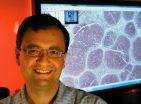(Press-News.org) New Haven, Conn.—A team of Yale University scientists has synthesized for the first time a chemical compound called lomaiviticin aglycon, leading to the development of a new class of molecules that appear to target and destroy cancer stem cells.
Chemists worldwide have been interested in lomaiviticin's potential anticancer properties since its discovery in 2001. But so far, they have been unable to obtain significant quantities of the compound, which is produced by a rare marine bacterium that cannot be easily coaxed into creating the molecule. For the past decade, different groups around the world have been trying instead to synthesize the natural compound in the lab, but without success.
Now a team at Yale, led by chemist Seth Herzon, has managed to create lomaiviticin aglycon for the first time, opening up new avenues of exploration into novel chemotherapies that could target cancer stem cells, thought to be the precursors to tumors in a number of different cancers including ovarian, brain, lung, prostate and leukemia. Their discovery appears online today in the Journal of the American Chemical Society.
"About three quarters of anticancer agents are derived from natural products, so there's been lots of work in this area," Herzon said. "But this compound is structurally very different from other natural products, which made it extremely difficult to synthesize in the lab."
In addition to lomaiviticin aglycon, Herzon's team also created smaller, similar molecules that have proven extremely effective in killing ovarian stem cells, said Gil Mor, M.D., a researcher at the Yale School of Medicine who is collaborating with Herzon to test the new class of molecules' potential as a cancer therapeutic.
The scientists are particularly excited about lomaiviticin aglycon's potential to kill ovarian cancer stem cells because the disease is notoriously resistant to Taxol and Carboplatin, two of the most common chemotherapy drugs. "Ovarian cancer has a high rate of recurrence, and after using chemotherapy to fight the tumor the first time, you're left with resistant tumor cells that tend to keep coming back," Mor explained. "If you can kill the stem cells before they have the chance to form a tumor, the patient will have a much better chance of survival – and there aren't many potential therapies out there that target cancer stem cells right now."
Herzon's team, which managed to synthesize the molecule in just 11 steps starting from basic chemical building blocks, has been working on the problem since 2008 and spent more than a year on just one step of the process involving the creation of a carbon-carbon bond. It was an achievement that many researchers deemed impossible, but while others tried to work around having to create that bond by using other techniques, the team's persistence paid off.
"A lot of blood, sweat and tears went into creating that bond," Herzon said. "After that, the rest of the process was relatively easy."
Next, the team will continue to analyze the compound to better understand what's happening to the stem cells at the molecular level. The team hopes to begin testing the compounds in animals shortly.
"This is a great example of the synergy between basic chemistry and the applied sciences," Herzon said. "Our original goal of synthesizing this natural product has led us into entirely new directions that could have broad impacts in human medicine."
###
Other authors of the paper include Liang Lu, Christina M. Woo and Shivajirao L. Gholap, all of Yale University.
DOI: 10.1021/ja200034b
END
Researchers at National Jewish Health have discovered a signaling pathway that is crucial to the devastating effects of acute lung injury (ALI). The data, obtained from cells, animals and ALI patients, suggest several potential therapeutic targets. Experimental blockade of one of the targets significantly reduced flooding of the lungs that is the hallmark of ALI.
"Acute lung injury is a devastating disease, with 40 percent mortality and no beneficial therapies," said first author James Finigan, MD, Assistant Professor of Medicine at National Jewish Health. "Our study ...
It takes songbirds and baseball pitchers thousands of repetitions – a choreography of many muscle movements -- to develop an irresistible trill or a killer slider. Now, scientists have discovered that the male Bengalese finch uses a simple mental computation and an uncanny memory to create its near-perfect mate-catching melody -- a finding that could have implications for rehabilitating people with neuromuscular diseases and injuries.
Young male Bengalese finches practice their boisterous mating song hundreds of times a day, comparing their melody to the songs of their ...
Researchers have found that a novel form of personalized therapy that genetically engineers a patient's own anti-tumor immune cells to fight tumors could treat metastatic melanoma and metastatic synovial cell sarcoma, representing a potentially new therapeutic approach against these and other cancers.
The technique, called adoptive immunotherapy, works with the body's immune system to fight cancer. Immune cells, called T lymphocytes, are removed, modified, expanded in large numbers, and given back to the patient. In this case, the process entailed genetically engineering ...
Researchers are leveraging Ohio Supercomputer Center resources to develop computer-assisted diagnosis tools that will provide pathologists grading Follicular Lymphoma samples with quicker, more consistently accurate diagnoses.
"The advent of digital whole-slide scanners in recent years has spurred a revolution in imaging technology for histopathology," according to Metin N. Gurcan, Ph.D., an associate professor of Biomedical Informatics at The Ohio State University Medical Center. "The large multi-gigapixel images produced by these scanners contain a wealth of information ...
Drug- and explosives-sniffing dog/handler teams' performance is affected by human handlers' beliefs, possibly in response to subtle, unintentional handler cues, a study by researchers at UC Davis has found.
The study, published in the January issue of the journal Animal Cognition, found that detection-dog/handler teams erroneously "alerted," or identified a scent, when there was no scent present more than 200 times — particularly when the handler believed that there was scent present.
"It isn't just about how sensitive a dog's nose is or how well-trained a dog is. There ...
Tropical Storm Anthony made landfall in Queensland, Australia this past weekend, and now the residents are watching a larger, more powerful cyclone headed their way. NASA's Terra satellite captured a visible image of the large Tropical Cyclone Yasi late yesterday as it makes its way west through the Coral Sea toward Queensland.
The Moderate Resolution Imaging Spectroradiometer (MODIS) instrument that flies aboard NASA's Terra satellite captured an image of Cyclone Yasi on Jan. 30 at 23:20 UTC (6:20 p.m. EST/09:20 a.m., Monday, January 31 in Australia/Brisbane local time). ...
NASA's Time History of Events and Macroscale Interaction during Substorms (THEMIS) spacecraft combined with computer models have helped track the origin of the energetic particles in Earth's magnetic atmosphere that appear during a kind of space weather called a substorm. Understanding the source of such particles and how they are shuttled through Earth's atmosphere is crucial to better understanding the Sun's complex space weather system and thus protect satellites or even humans in space.
The results show that these speedy electrons gain extra energy from changing magnetic ...
(Santa Barbara, Calif.) –– Inspired by the popular confidence trick known as "shell game," researchers at UC Santa Barbara have demonstrated the ability to hide and shuffle "quantum-mechanical peas" –– microwave single photons –– under and between three microwave resonators, or "quantized shells."
In a paper published in the Jan. 30 issue of the journal Nature Physics, UCSB researchers show the first demonstration of the coherent control of a multi-resonator architecture. This topic has been a holy grail among physicists studying photons at the quantum-mechanical level ...
Children from poorer families do worse in school, are less likely to graduate from high school, and are less likely to go to college. A new study published in Psychological Science, a journal of the Association for Psychological Science, finds that these differences appear surprisingly early: by the age of 2. It's not a genetic difference. Instead, something about the poorer children's environment is keeping them from realizing their genetic potentials.
Past research has found that a gap between poor children and children from wealthier families opens up early in life, ...
ANN ARBOR, Mich.--Brain scans showing neural reactions to pro-health messages can predict if you'll keep that resolution to quit smoking more accurately than you yourself can. That's according to a new study forthcoming in Health Psychology, a peer-reviewed journal.
"We targeted smokers who were already taking action to quit," says Emily Falk, the lead author of the study and director of the Communication Neuroscience Laboratory at the U-M Institute for Social Research (ISR) and Department of Communication Studies. "And we found that neural activity can predict behavior ...


